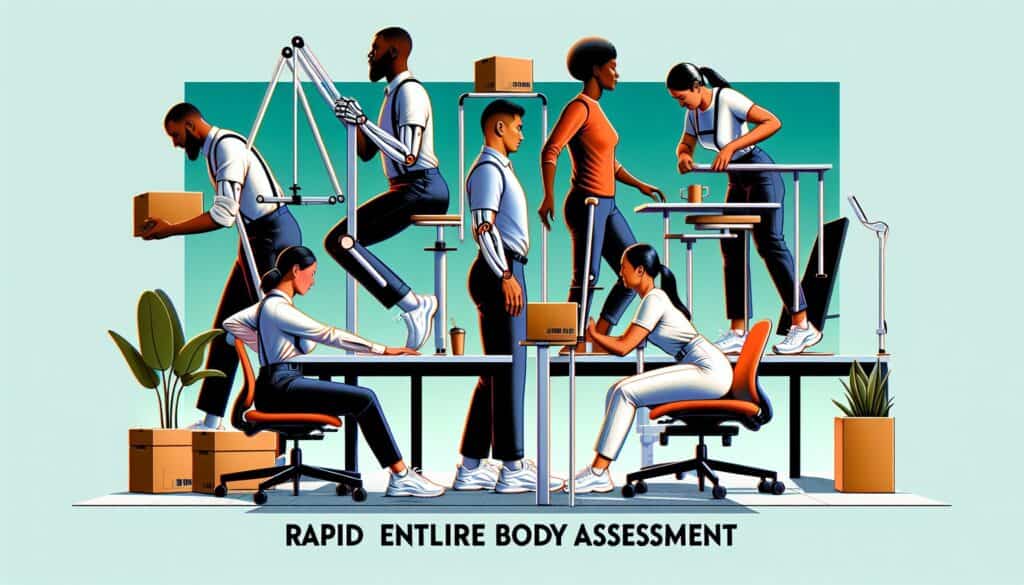Una herramienta de observación utilizada para evaluar los riesgos posturales de trastornos musculoesqueléticos de todo el cuerpo relacionados con el trabajo.
- Metodologías: Economía, Lean Sigma, Fabricación, Resolución de problemas, Calidad
REBA (Evaluación rápida de todo el cuerpo)

REBA (Evaluación rápida de todo el cuerpo)
- Mejora continua, Ergonomía, Human Factors, Diseño centrado en el ser humano, Manufactura esbelta, Mejora de procesos, Gestión de calidad, Gestión de riesgos, Seguridad
Objetivo:
Cómo se utiliza:
- Evalúa las posturas del cuello, tronco, piernas y brazos, así como el acoplamiento, la carga/fuerza y la actividad. Se generan puntuaciones para indicar el nivel de riesgo de TME y la urgencia de la intervención.
Ventajas
- Proporciona una evaluación holística de los riesgos posturales de todo el cuerpo; su uso es relativamente rápido; ayuda a priorizar los trabajos que requieren mejoras ergonómicas.
Contras
- Puede ser subjetivo; requiere formación para una puntuación coherente; principalmente una herramienta de cribado, puede necesitar un análisis más detallado para el diseño de la intervención.
Categorías:
- Ergonomía
Ideal para:
- Evaluación de los riesgos posturales de los trastornos musculoesqueléticos que afectan a todo el cuerpo.
La metodología REBA (Rapid Entire Body Assessment, evaluación rápida de todo el cuerpo) se aplica en diversos sectores, como la industria manufacturera, la construcción, la sanidad y la logística, en los que los empleados realizan con frecuencia tareas que requieren movimientos repetitivos o posturas incómodas sostenidas. Esta evaluación es especialmente valiosa durante la fase de diseño de espacios o flujos de trabajo, sobre todo cuando se tienen en cuenta las exigencias físicas de los trabajadores, lo que permite a los equipos evaluar y rediseñar tareas específicas que podrían provocar lesiones. En contextos de ingeniería y diseño de productos, los participantes suelen ser ergónomos, profesionales de la salud y la seguridad y jefes de equipo encargados de optimizar los flujos de trabajo. La metodología facilita la evaluación objetiva mediante la generación de puntuaciones numéricas que categorizan el nivel de riesgo de trastornos musculoesqueléticos (TME) asociado a posturas y tareas específicas, priorizando así los puestos de trabajo para intervenciones ergonómicas. La rápida aplicación del REBA fomenta su uso en evaluaciones rutinarias, lo que permite a las empresas supervisar periódicamente los cambios en las posturas y las condiciones de trabajo, con el objetivo último de reducir las tasas de lesiones y mejorar el bienestar de los trabajadores. Podrían organizarse sesiones de formación para educar a los empleados de todos los niveles sobre el REBA, cultivando una conciencia de los principios ergonómicos que promueven un entorno de trabajo más seguro. La aplicación regular de estas evaluaciones no sólo ayuda a cumplir las directrices de salud laboral, sino que también mejora la productividad al reducir la fatiga y el absentismo asociados a los TME.
Pasos clave de esta metodología
- Observe la postura del trabajador durante la tarea.
- Califique la postura del cuello, tronco, piernas y brazos utilizando criterios de puntuación predefinidos.
- Evaluar el nivel de acoplamiento entre las partes del cuerpo durante la tarea.
- Evaluar cualquier carga o fuerza ejercida sobre el cuerpo.
- Tenga en cuenta la actividad específica que se va a realizar y sus exigencias.
- Calcule la puntuación total a partir de las puntuaciones individuales.
- Determinar el nivel de riesgo de trastornos musculoesqueléticos en función de la puntuación.
- Priorizar la necesidad de intervención basándose en los resultados de la evaluación.
Consejos profesionales
- Incorporar un enfoque de evaluación dinámica combinando los resultados del REBA con un estudio de tiempo-movimiento para mejorar la comprensión de las tareas repetitivas y su impacto en la postura del trabajador.
- Utilizar herramientas digitales, como el software de captura de movimientos, para complementar el análisis REBA con el fin de identificar con mayor precisión los riesgos posturales y la aplicación de fuerzas.
- Actualizar periódicamente los criterios de puntuación del REBA basándose en las nuevas investigaciones y en las mejores prácticas para garantizar la pertinencia y la precisión en la evaluación de los entornos de trabajo modernos.
Leer y comparar varias metodologías, recomendamos el
> Amplio repositorio de metodologías <
junto con otras más de 400 metodologías.
Sus comentarios sobre esta metodología o información adicional son bienvenidos en la dirección sección de comentarios ↓ , así como cualquier idea o enlace relacionado con la ingeniería.
Contexto histórico
1986
(si se desconoce la fecha o no es relevante, por ejemplo "mecánica de fluidos", se ofrece una estimación redondeada de su notable aparición)

Publicaciones relacionadas
Gestión de operaciones de fabricación (MOM)
Sistema de Ejecución de Fabricación (MES)
Plan de control de la fabricación
Pruebas manuales
Tablas de evaluación de la manipulación manual (MAC)
ManTRA (Herramienta de evaluación de riesgos en las tareas manuales)